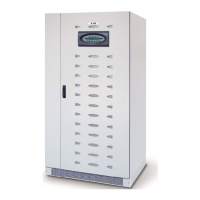0MNA080A55-GB REV 01 page 11 / 75
2. Installation environment
The SENTRY MPS-HP and the battery cabinet have been designed for indoor installation. The choice of premises
for installation should comply with the points set out below.
2.1 Ambient conditions:
• ensure that the floor can support the weight of the SENTRY MPS-HP and of any battery cabinet that
may be used;
• avoid dusty environments;
• avoid narrow environments that could hinder normal maintenance operations;
• avoid placing the device in areas exposed to direct sunlight or heat;
• ensure that the ambient temperature conforms to the following:
minimum operating temperature: 0 °C
maximum temperature for 8 hours a day: + 40°C
average temperature for 24 hours: + 35°C
2.2 Dimensions of the premises
For the mechanical dimensions of the cabinets, refer to the “INSTALLATION DRAWINGS” supplied with the
UPS and with the battery cabinet, if present. These drawings provide the following data:
• the position of the holes in the base to secure the device to the floor, if applicable;
• the view of the floor support for the sizing of a structure to raise the cabinet, if applicable;
• the position of cable entry;
• the position of the fans on the top of the UPS, for the positioning of a structure to convey the warm air
discharged by the equipment outside the premises, if applicable;
• the input, output and battery cables section;
• the power dissipated by the equipment (kW).
2.3 Cooling of the premises
N.B.: the recommended operating temperature for the lifetime of the UPS and of the batteries is between 20 and
25°C. The lifespan of the battery depends on the operating temperature; with an operating temperature of between
20°C and 30°C, the lifespan of the batteries is halved
.
A heat dissipation system is required to keep the temperature of the premises housing the equipment within the field
20÷25°C.
The heat dissipation needed for the correct operation of the UPS is
brought about by the air current made by the fans located inside the
UPS (forced convection) and by the air around the side panels
(natural convection).

